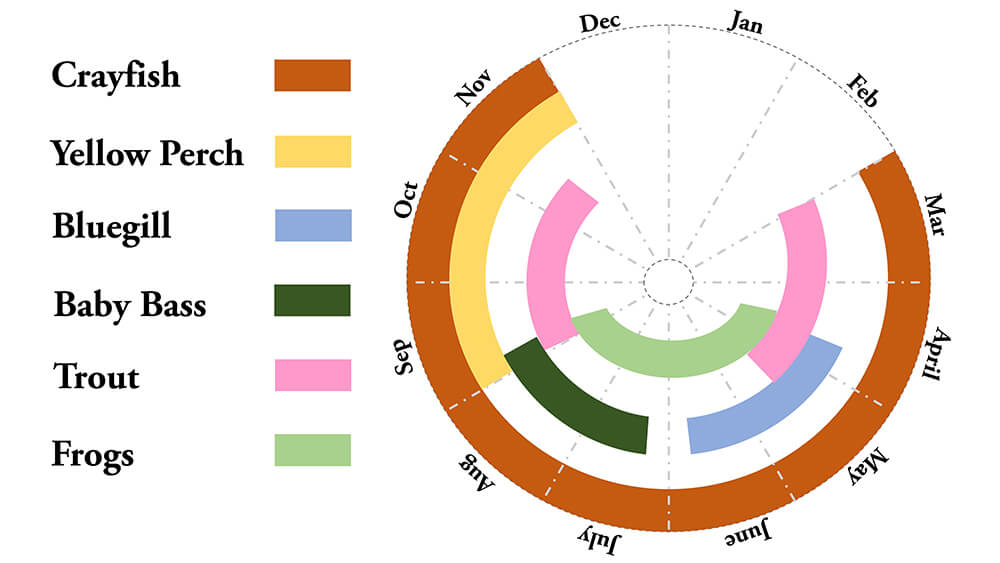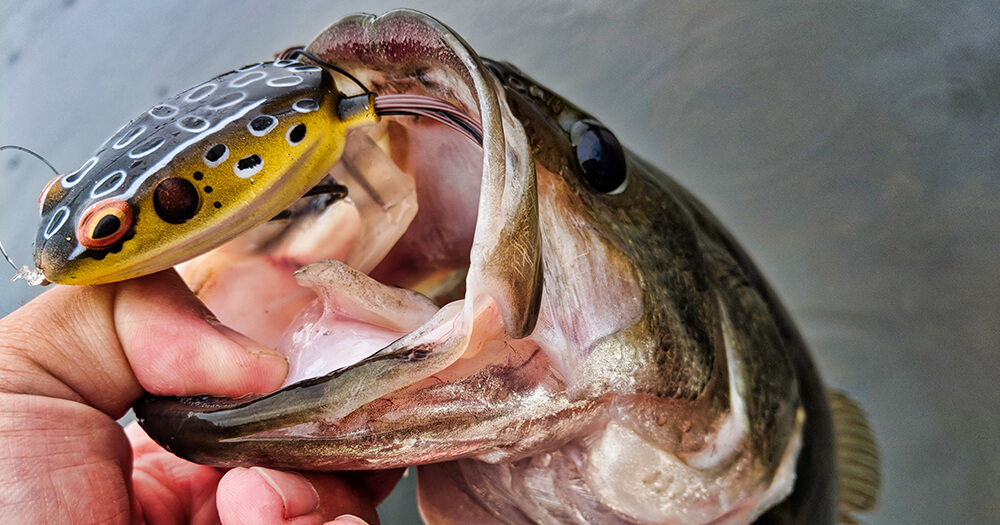Matching the Hatch for Northwest Largemouth Bass
By: Tyler Hicks
I grew up fishing for bass in the Great Plains and southeast United States. Most of the reservoirs there were loaded with shad, minnows, and shiners. The food chains in these lakes revolved greatly around these baitfish and if you wanted to find bass, outside of pre-spawn and spawning season, then locating these baitfish was often key to locating schools of hungry bass.
Fast forward a decade, graduate school and abundant public lands drew me to the Pacific Northwest where bass fishing is nothing like I had experienced before. The lakes here are crystal clear, cold, and chock full of vegetation, a far cry from the muddy and green-colored water I was accustomed to fishing. More importantly, the food web in these lakes was drastically different. No shiners. No shad. No minnows. In fact fishing with live baitfish is illegal here. Strangely absent is the smell of minnows and the sound of bubblers in every tackle shop.
The food webs here vary greatly by lake and dialing in the right patterns for the local Largemouth Bass population requires some sleuthing and time on the water. I should preface that I don't always find bass to be all that particular about what they eat. Honestly, there is nothing naturally chartreuse in the evolutionary history of bass that compels them to eat something that glows like a spent nuclear rod but they will eat it anyways. For me "matching the hatch", to borrow a fly fishing term, gives me the confidence that I'm putting something in front of their face that they have eaten before and will likely eat again. I believe in confidence. A confident angler fishes harder and longer and catches more fish as a result.
Largemouth Bass season runs from March through November here in the upper left. I've found that there are six primary prey items that are available in many of the regions lakes that form the prey base for most Largemouth Bass fisheries in the region. I tend to cycle through various prey imitations depending on the time of year and body of water (Fig. 1).

- Crayfish – Owing to the regions young volcanic crust, the majority of our lakes are rocky and harbor good populations of crayfish. This makes them an important food item for Northwest Largemouth Bass. The importance of crayfish is reflected in that I will throw crayfish patterns at any time of the season and they will always produce. Often times you can tell if bass in local lakes are feeding heavy on crayfish as their lips will turn vibrant red from rooting around in the rocks in pursuit crawfish. The region is home to only one species of native crayfish, Signal Crayfish, which are primarily dark brown with bright orange on the underside of their pinchers.
- Trout – Every spring and fall our local fish and wildlife agencies dump millions of 4 to 15" trout in our local bass lake. These fish, having been raised in concrete tanks, are completely naïve to predators, and the bass take full advantage. In the spring and fall I will throw a variety of Rainbow Trout colored crankbait and jerkbaits and bring plenty of green fish to the kayak. Most of all, this is the time of year I pull out the giant swimbaits and spend my day hucking 14" to 16" Hudd swimbaits with the hopes of bringing in a mondo Largie.
- Bluegill – Found in many regional bass lakes, especially on the eastern slope of the Cascades, Bluegill are an important spring and early summer pattern for me. Largemouth Bass will typically spawn in most Pacific Northwest lakes from April to as late as June or July depending on water temperatures. Immediately following the bass spawn, Bluegill will move up to spawn and also feed on bass fry. This is a great time to capitalize on male Largies defending their fry balls by throwing small Bluegill patterned swimbaits, spinnerbaits, or square bills. Early in the Bluegill season I love throwing big Bluegill swimbaits and have often been rewarded with some absolute toad female bass including my personal best Northwest Largemouth Bass that tipped the scales at 8.5 lbs.
- Frogs – After last year's ICAST I went bass fishing on Lake Toho in central Florida and was amazed to find a consistent frog bite all day. This was even during the sweltering heat of a Florida summer day. The frog bite in the Pacific Northwest is far from consistent but can be productive in the first and final hours of the day from late spring thru summer. In early spring before weedbeds have engulfed the shoreline you will find bass holding tight to shore. You can cast frogs right onto the bank and expect vicious strikes tight to shore. As the season progresses target cut banks, floating cattail ledges, and lily pads. Frog bites in open water are not typical here but in the failing light of the evening you can sometimes draw a strike. Think outside the box here as well many of the lakes on the eastern slope of the Cascades are in a desert setting that supports numerous rodents and snakes. I've done better on topwater snakes and rats at some lakes than frogs.
- Baby Bass – If a lake supports a population of Largemouth Bass then it for certain supports baby bass and baby bass are as much food as any other critter. After the spawn most of the larger bass move back offshore to feed. I typically will find these fishing hanging on deepwater weedlines in 10-20' of water, rock piles, and other structures such as fallen trees or docks. In these same places you will find schools of baby bass as well. Plastic shads in baby bass pattern fished on a dropshot or on a weighted wide gap hook and fished like a jerkbait can be deadly. One of my favorite rigs is a Zoom Superfluke in baby bass pattern fished on a shaky head on the edge of deep weedlines.
- Yellow Perch – In the fall large schools of perch congregate on lake ledges as they prepare to move out onto deep water flats to spend the winter. This brings them into contact with bass that are both moving up from their deep water summer haunts and bass that spent the summer in shallow water that are now looking to do deep for winter. Crankbaits and deep diving jerkbaits in perch patterns are a go to for me during the fall. I use these as search baits and tend to favor heavier lures this time of year that I can cast far and retrieve fast. Once I locate fish I may switch up to swimbaits or neko rigged senkos in perch pattern.
A variety of Old Town's kayaks will serve a Pacific Northwest bass angler's needs but some models will allow anglers to capitalize on other fisheries in the region. I fish out of a Sportsman PDL 120 and find it equally at home on the Puget Sound and Columbia River in pursuit of salmon as I do fishing for bass on the region's many lakes. Recently I acquired a Sportsman AutoPilot 120 and have enjoyed the many features of this kayak especially Spot Lock which allows me to anchor with a push of a button and hold in the blustery winds that dominate the Columbia Basin. Whether you are seasoned kayak bass angler or just bass curious there are a lifetime's worth of water to fish in the Pacific Northwest with quality bass in excess of 5 lbs just waiting for a grip and grin photo shoot on your kayak.







